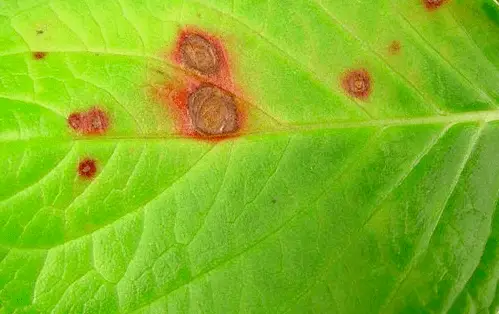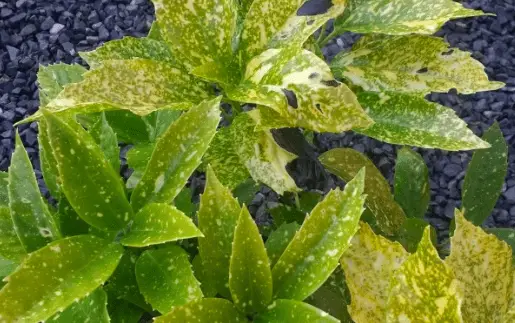Aucuba japonica, also known as Japanese laurel, is a popular evergreen shrub that is often used in landscaping. While it is relatively easy to care for, there are a few diseases that can affect this plant.
In this blog post, we will discuss three of the most common Aucuba Japonica Diseases: leaf spot, powdery mildew, and rust. We will also provide tips on how to prevent these diseases from affecting your plants!
Common Aucuba Japonica Diseases
The most common Aucuba Japonica diseases include Phyllosticta leaf spot, Phomopsis stem dieback, nonpathogenic root rot, and Fungal anthracnose. Each of these diseases usually only affects a portion of the plant but can cause serious damage if left untreated.
I will now go into more detail about each disease so that you can be on the lookout for them!
1. Phyllosticta Leaf Spot
This disease is caused by the Phyllosticta minima fungus and usually appears as small, dark spots on the leaves of the plant. These spots are also usually surrounded by a red border. These spots can eventually lead to leaf death if left untreated.
The best way to prevent Phyllosticta Leaf Spot is to practice good garden hygiene by removing any dead leaves or debris from around the plant. Also, make sure to water the plant at the base of the stem and not on the leaves to reduce the chances of this disease developing.
There is no fungicide that specifically targets Phyllosticta disease, but tebuconazole-based fungicides are great against pathogenic fungi.

2. Phomopsis Stem Dieback
This disease is caused by the Phomopsis fungi and usually appears as brown or black lesions on the stems of the plant. These lesions start at the base of the plant and can eventually kill the entire stem if left untreated.
To prevent Phomopsis stem dieback, make sure to prune any dead or diseased stems from the plant. Also, avoid watering the plant from above as this can spread the fungus to other parts of the plant.
I recommend pruning any dead or diseased stems from the plant as soon as you see them. This will help to prevent the disease from spreading through the entire plant and killing it.
3. Fungal Anthracnose
This disease is caused by the Colletotrichum fungi and appears as small, dark spots on the leaves of the plant. Anthracnose is one of the most popular diseases for all plants, not just Aucuba japonica.
It thrives in moist conditions, which is why it frequently affects plants in the springtime when the weather is wet and still relatively cool. Dry, hot weather doesn’t allow the fungi spores to spread and infect new leaves.
To stop your Aucuba Japonica from developing this disease, you should avoid wetting the leaves when watering and make sure the plant has good air circulation. You can also use a fungicide that contains chlorothalonil to help prevent the disease from developing. Copper fungicide is another good option as it will kill the fungi spores before they have a chance to infect the plant.

4. Root Rot
Root rot is another common disease that can affect Aucuba japonica. This disease usually starts with the roots of the plant but can eventually spread to the leaves and stems if left untreated.
The best way to prevent root rot is to make sure the plant is not sitting in water. If you notice the leaves of the plant starting to turn yellow or brown, this is a sign that the roots are beginning to rot.
Inspect the roots of your plant regularly and if you notice any that are brown or black, cut them off immediately. The goal is to stop the rot from spreading to the rest of the plant. In some cases, it will be too late and the plant will die.
Can My Aucuba Japonica Recover from Root Rot?
Yes, it is possible for your Aucuba Japonica to recover from root rot if you catch it early enough. However, you must act quickly as this disease can spread quickly and kill the plant if left untreated.
If you suspect that your plant has root rot, the first thing you should do is remove it from the ground/pot and inspect the roots. If they are black or mushy, cut them off immediately.
Next, replant the Aucuba Japonica in fresh soil and make sure the pot has drainage holes to allow for proper drainage. Water the plant regularly, but make sure not to overwater as this can cause the root rot to come back.
It will take some time for your plant to recover, but if you follow these steps, it should be able to bounce back relatively quickly.
Should I Prune Diseased Foliage from My Aucuba Japonica?
Yes, it can be a good idea to prune diseased foliage from your Aucuba Japonica. This will help to prevent the disease from spreading and infecting other parts of the plant. The quicker you catch the disease, the easier it will be to treat.
If you notice any leaves that are brown or black, cut them off immediately and dispose of them. It’s also a good idea to sterilize your pruning shears after each use to prevent the disease from spreading.
Conclusion
In conclusion, there are several diseases that can affect Aucuba Japonica. Some of the most common include Phyllosticta leaf spot, Phomopsis stem dieback, fungal Anthracnose, and root rot.
To prevent these diseases from occurring, make sure to keep your garden clean and free of debris. Also, be careful with watering as too much or too little water can lead to plant stress which makes them more susceptible to diseases.
If you do notice any of these diseases developing, act quickly as they can spread quickly and kill the plant if left untreated. Prune off any affected leaves and/or stems and dispose of them immediately.
Tim is an avid gardener from the UK. He was the founder of PlantCarer.com from 2021 to Sep 2023. He sold PlantCarer.com to Aaron. He has since started his own business called Seed To Supper, which provides new gardeners all the materials you need in a box (pots, seeds, compost and instructions) to grow your own delicious and nutritious vegetables and herbs from start to finish – no garden required.










0 Comments